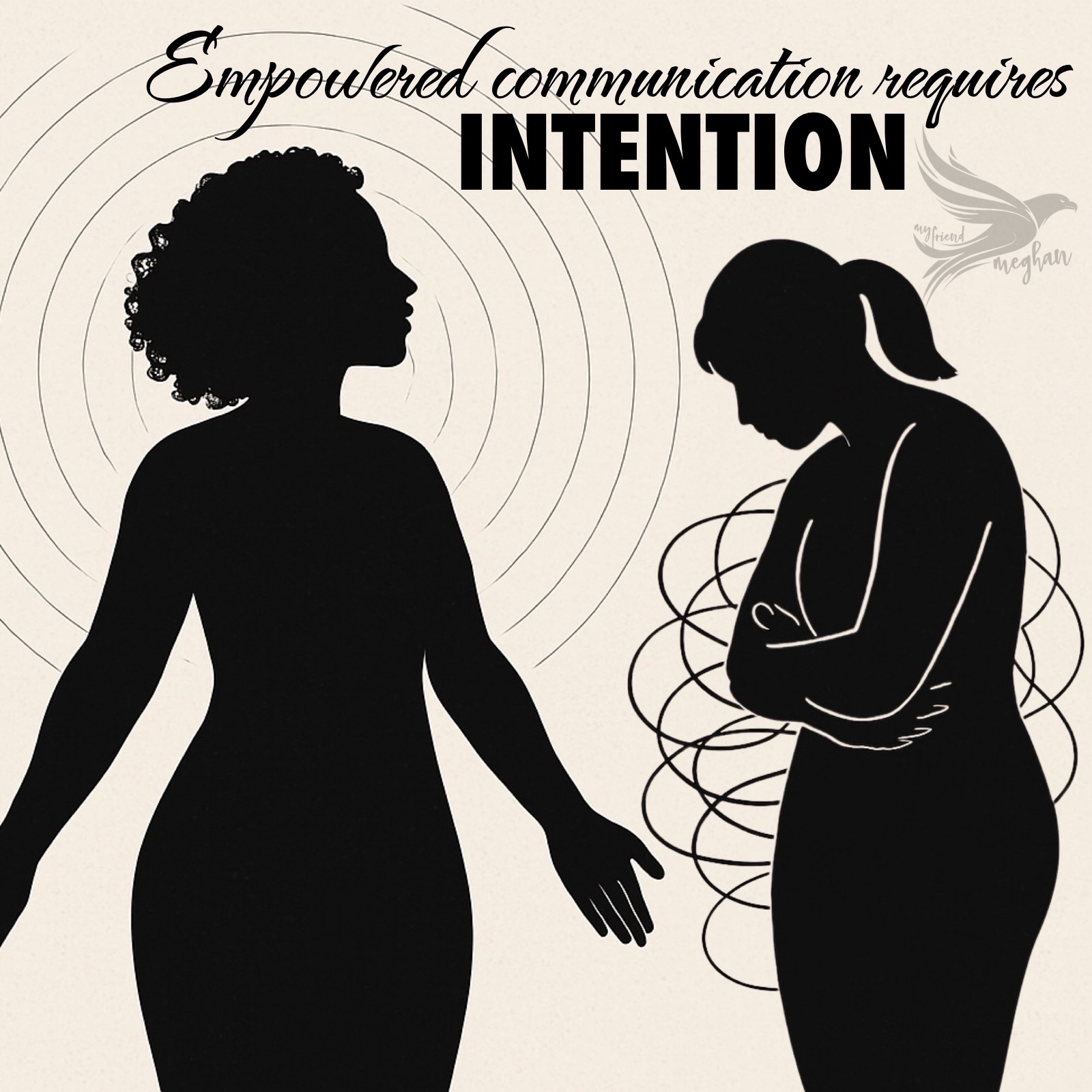Communication is more than just the words we say—it’s how we show up in our relationships, how we set boundaries, and how we engage with the world. Empowered communication isn’t about controlling the narrative or convincing others to see things our way. It’s about standing in our truth with clarity, confidence, and grace while fully expecting and encouraging others to do the same.
Here are thirteen key concepts that cultivate empowered communication, helping us navigate conversations, relationships, and even our own inner dialogue with strength and self-awareness.
1. You Are Responsible for the Energy You Bring
You alone are responsible for the energy you bring into an interaction. Whether you show up with peace, chaos, defensiveness, or openness—that’s your choice. Other people may bring toxic energy into a space, but it’s up to you whether you meet them there or hold your own vibration steady.
Choosing to elevate your thought allows you to shift the tone of a conversation and even a relationship. If you consistently show up from a place of fear, control, or frustration, you’re contributing to a lower vibrational dynamic. But if you consciously transmute that energy into trust, compassion, and clarity, you have the power to raise the frequency of the space you’re in.
2. Power vs. Force
Operating in power or authority—expanded, unhindered energy flow—is far more effective than using force—striving, control, contracted energy. When you move from a place of authority, things unfold naturally, and your presence carries weight without the need for excessive effort.
When you rely on force, everything feels like an uphill battle. The more you push, the more resistance you create. Recognizing when you are forcing an outcome versus allowing flow can transform how you engage with situations and people. Operating in force consumes far more energy, while authority conserves it. So move in power rather than force.
3. Energy as Currency
Every word, reaction, or engagement costs something—your energy is currency. Engaging in conflict or rumination drains you without return, while silence, discernment, and intentionality protect your peace. Resist the urge to be reactionary, and instead be intentional. Before you invest your energy, ask yourself: is this worth the cost?
4. Healthy Boundaries and Letting Go
Establishing boundaries includes not just what you allow from others, but also what you allow yourself to obsess over. Being mindful of what is within your sphere of influence and not wasting your focus or energy on things outside of that is a key part of maintaining your peace. Letting go of situations you cannot control prevents unnecessary suffering and conserves your energy.
5. Release the Illusion of Control
You cannot control how others perceive you, what they say about you, or how they respond to situations. Trying to manage someone else’s reactions or thoughts is an overstep into their free will and leads to unnecessary stress.
The key to peace is staying within your sphere of influence—your own energy, actions, and responses—rather than expending energy trying to control external factors.
6. Release and Transmute Energy
Holding onto negative thoughts and anxieties fuels them, making them more likely to manifest. Just like hoarding stagnant energy in your body can make you feel weighed down, clinging to mental clutter does the same.
Instead of feeding negativity, choose to transmute energy—release what is no longer needed and elevate your thought, shifting fear into trust, anger into clarity, and frustration into forward movement. Your focus determines whether you’re expanding or contracting your energy.
7. The Role of Forgiveness in Energy Release
Forgiveness isn’t just about letting go—it’s about severing karmic ties and freeing yourself from energetic entanglement. When you release the need to hold onto anger, blame, or disappointment, you reclaim the energy that was bound to the situation or person.
Holding onto resentment or fear about what someone may say or do keeps you energetically tied to them. Forgiveness becomes a conscious act of liberation—one that restores your peace and creates space for new, healthy connections to flourish.
8. Know Your Own Weaknesses
Self-awareness is key. Understanding your own tendencies allows you to navigate interactions more effectively. A couple of examples are:
- Oversharing – If you know you’re prone to oversharing, be mindful of when and why you share personal details. Vulnerability is valuable, but it should be intentional rather than impulsive.
- Overexplaining – If you tend to overexplain, remember that giving additional information is an invitation for the other person to judge your decisions, which is not something you want to invite them to do. A clear, concise statement is often more powerful than a lengthy justification.
9. The Importance of Self-Validation
Seeking external validation for your worth, experiences, or decisions creates a dependence on others’ often fickle approval. True peace comes from learning to affirm yourself, be your own witness, and trust your own perspective, rather than outsourcing your confidence to opinions that can shift on a whim.
10. Thought Patterns Shape Reality
What you dwell on internally becomes the lens through which you interpret your world, and over time, those interpretations become your reality. When you move through the world expecting betrayal, disappointment, or drama, you subconsciously attune yourself to those patterns. You notice every confirming detail and miss opportunities for peace or connection.
But when you shift your internal narrative toward trust, peace, and the possibility of goodness, everything changes. You’re more likely to respond from a centered place, to recognize support when it shows up, and to co-create relationships that reflect your elevated perspective. So monitor your thoughts to shape the reality you prefer.
11. Manifestation and Mental Focus
Every thought, fear, or worry exists in consciousness and carries the potential to become reality. Your mental focus is a powerful creative tool—what you dwell on is what you amplify. Redirecting your thoughts toward positive possibilities rather than worst-case scenarios can shift outcomes in your favor and align your energy with what you truly want to experience.
In communication, this plays out in subtle but profound ways. When you expect the worst from someone, you’re more likely to notice behavior that confirms that belief. But when you hold space for goodness—trusting their heart, assuming positive intent—you create room for healthier connection and mutual understanding.
12. Trust the Timing of Others’ Journeys
Empowered communication means respecting the pace and path of someone else’s growth—even when it diverges from your own. Just as you want your process respected, others deserve the same space to grow and evolve. If a door isn’t open, trust that it’s not your time to walk through it. Alignment works both ways—it can’t be right for one and wrong for the other.
When you release the need to force outcomes, you create space for synchronicity and divine timing to work on your behalf. Hold the posture of this or something better, and trust that the universe is coordinating the details in ways that may be better than anything you could have orchestrated on your own.
13. The Art of Non-Reaction
Not every situation requires a response—sometimes disengagement is the most powerful move. Reacting emotionally gives away your power; staying neutral keeps you rooted in your own energy and clarity. When you remove your attention and energy from a situation, it begins to lose momentum—what you stop feeding, stops growing.
Closing Thoughts
Empowered communication isn’t about having all the right words or controlling the outcome of interactions. It’s about knowing where to invest your energy, trusting that the truth doesn’t need defending, and recognizing that your worth isn’t dependent on someone else’s understanding.
The more you are aware of these keys, the more freedom and ease you’ll find in your conversations—and in life as a whole.
Actionable Insights
- Which of these keys do you already embody? Take a moment to acknowledge the areas where you already communicate from a place of empowerment. Recognizing your strengths helps reinforce them.
- Which one or two keys feel most important for you to implement next? Instead of trying to integrate everything at once, choose one or two key shifts to focus on first. Build from there as they become second nature.
- Where do you notice the most resistance? If there’s a key that feels particularly hard to embrace, that might be the one that holds the most transformation for you. Approach it with curiosity rather than judgment.
The 13 Keys are:
- You Are Responsible for the Energy You Bring
- Power vs. Force
- Energy as Currency
- Healthy Boundaries and Letting Go
- Release the Illusion of Control
- Release and Transmute Energy
- The Role of Forgiveness in Energy Release
- Know Your Own Weaknesses
- The Importance of Self-Validation
- Thought Patterns Shape Reality
- Manifestation and Mental Focus
- Trust the Timing of Others’ Journeys
- The Art of Non-Reaction


Leave a Reply